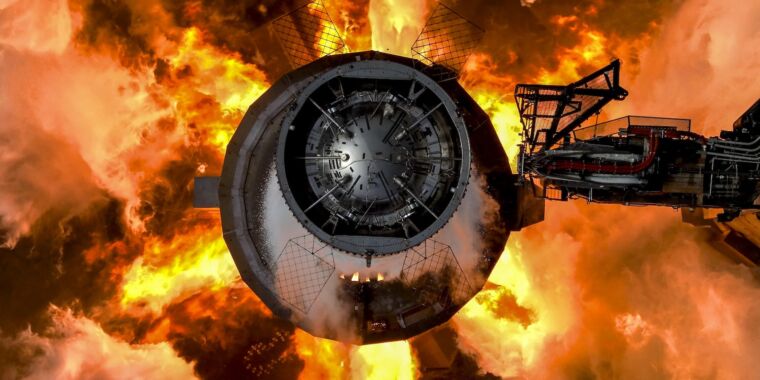It’s still unclear how long SpaceX’s workhorse Falcon 9 rocket will remain grounded as engineers investigate an unusual launch failure last week, but the next test flight of the company’s next-generation Starship spacecraft appears to be on track for liftoff next month.
SpaceX conducted a test firing of 33 Raptor engines aboard its Starship rocket’s Super Heavy booster at the company’s StarBase facility in South Texas on Monday. The methane-fueled engines fired for about eight seconds, long enough for SpaceX engineers to ensure all systems were working properly. At full power, the 33 engines produced nearly 17 million pounds of thrust, twice the power of NASA’s iconic Saturn V moon rocket.
SpaceX confirmed that the static burn test had reached its full duration, with the team venting methane and liquid oxygen from a rocket in the company’s inventory of spacecraft and boosters known as Booster 12. The upper stage for the next Starship test flight, Ship-30, completed a static burn of its six Raptor engines in May.
Between Starship’s fourth flight on June 6thSpaceX successfully guided its Super Heavy booster into a controlled splashdown in the Gulf of Mexico, east of Starbase, after which the spacecraft continued into space, traveled halfway around the Earth, and then re-entered the atmosphere for a guided splashdown in the Indian Ocean.
It was the first time SpaceX had successfully landed a booster and spacecraft close to its intended splashdown site, and the Super Heavy booster’s successful splashdown gave SpaceX officials confidence that they could recover the booster on its next flight to Starbase, where the tower’s giant articulating arms (colloquially known as “chopsticks”) will attempt to catch the rocket as it slows to a hover just above the pad.
SpaceX Starbase General Manager Cathy Lueders told Locals last month that SpaceX is still considering whether to attempt to catch the booster on its next flight. While the concept is bold and quite different from how SpaceX retrieves its Falcon 9 boosters, SpaceX officials believe it’s the best way to ensure the booster is quickly reusable. Earlier this month, SpaceX said Teaser video released for next Starship flight This suggests that booster catches are back on the table.
Flight 5 Super Heavy Booster full sustained static firing pic.twitter.com/8rF9KUdMUD
— SpaceX (@SpaceX) July 15, 2024
SpaceX also plans to test an improved heat shield for the hull, or upper stage, on Starship’s fifth test flight after heat from re-entry damaged the craft during descent during its previous flight last month.In a hangar a short drive from the launch pad, technicians are replacing thousands of ceramic tiles on the exterior of Ship-30.
Once that work is complete, SpaceX will stack the spacecraft on top of the booster and potentially conduct a full countdown rehearsal just days before the first launch, which could occur as early as August.
Meanwhile, construction is underway on a second launch pad at Starbase. Construction workers have stacked the first few segments of a lattice-like launch tower, a short distance from the existing Starship launch pad. Within a few years, SpaceX aims to have two operating launch pads in Texas and two Starship launch sites in Florida to accommodate the increasing rate of Starship flights.
These Starship missions will launch Starlink internet satellites, conduct in-orbit refueling tests, and support NASA’s Artemis lunar program.


